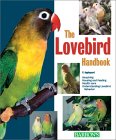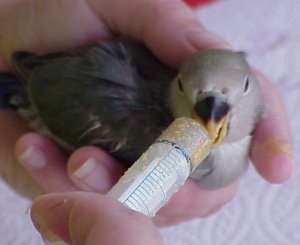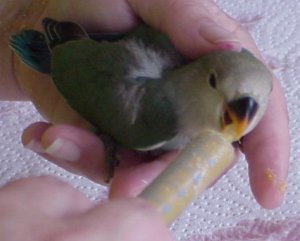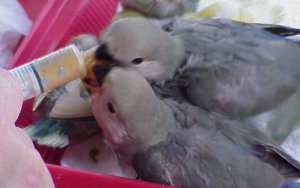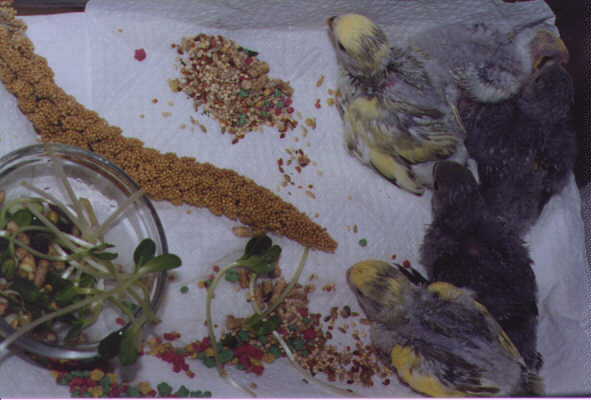Handfeeding & Socializing
f you haven’t read Part I of Breeding Lovebirds: A Beginner’s Guide, we suggest you go there first for the basics of breeding. This section covers raising lovebirds once the eggs have hatched.
Handfeeding Movies: Due to popular demand I’ve added some short mpg movies showing how to handfeed. Please note that this is not a substitute for being shown how to do this in person. Also note that I have already tested the temperature of the formula when these movies begin!
The First Few Days
The first few days after the eggs begin hatching can be nerve-rattling for beginners. Resist the temptation to check on the babies too often, but do make sure they are being properly fed by the parents. It is your job to make this stressful job as easy on the parents as possible. The male has to eat his food, regurgitate it for the hen, who in turn regurgitates the food for the babies. This involves enormous amounts of energy, and you might notice the male parent getting a little on the thin side. Later on, the male will help feed the babies himself rather than using the female as a go-between of sorts.
The number one way to ease the stress on the parents is to supply a wide variety of easy-to-digest foods on a regular basis. My parents always get more “meals” than other lovebirds. They need their water replaced more often (you’ll notice it gets dirtier much faster). They’ll prefer softer (hence fresh) foods that cannot be left in the cage for more than a few hours. For people working 9-5 jobs this can be difficult. I suggest giving fresh foods as soon as you get up in the morning, then removing anything that can spoil just before you leave for work. Leave in the cage millet, dried egg food (a powdery yellow food found at most avian supply stores) or Quiko, pellets (Roudybush seems the easiest for them-but they will make soup!), veggies that don’t spoil easily like sunflower sprouts or broccoli florets, and a good seed mix. Then give them fresh food when you arrive home and take it out after an hour or so.
Make sure the parents also have cuttlebone and plenty of water. I suggest two bowls of water during this period. They’ll usually make soup out of one right away, but will often leave one unsoiled for a few hours (place one far away from the other food bowls). This helps to avoid bacterial infections due to spoiled food sitting in water all day while you’re at work. It doesn’t always work since some piglets will immediately drop pellets into BOTH bowls of water. I’ve noticed that some parents particularly love what I call “Roudybush Soup.” They’ll drop the pellets in until it makes a thick soup. This can turn into a real primordial stew of death if left unchanged for more than a couple of hours. With those parents I must change the water a minimum of three times a day (usually by the third bowl they’ve moved on to greens, seeds, or other foods they don’t feel need soaking in the water bowl).
You’ll notice the babies will be on their backs for the first week. This is completely normal. Lovebirds always feed their babies on their backs, and if for some reason you are forced to pull lovebird babies that are newly born, you will have to do the same. Feeding Day-1 babies is extremely difficult and time-consuming and should not be attempted by a beginner. If you are forced to do this because the mother is ignoring the babies or attacking them, you should get help from an experienced hand-feeder. You will have to feed these babies every 15 minutes to half an hour if they are only a day old-right through the night. This can test the patience of most anyone. Because this is such a difficult (and usually unnecessary) process, I will not cover it here. Instead, I will discuss the more typical scenario or pulling 10-day-old chicks for hand-feeding.
WHEN TO PULL THE BABIES FOR HAND-FEEDING TO GET THE TAMEST BIRDS
In my experience, the tamest babies are pulled around 10-14 days. I generally pull the whole clutch when the YOUNGEST baby is about 9-10 days old. This generally means the oldest baby is around 16-17 days old. Frankly, I have had difficulty with birds pulled any later than 17 days. If there is a wide variance in hatching times within a single clutch, I’ll pull the oldest chicks before they are 15 days old and wait to pull the younger chicks. I place them in a large “brooder”-which I make by putting a few inches of Carefresh Cage Liner in a plastic reptile container (they are available at most pet stores and have brightly colored lids covered with slits for air). The lovebirds are generally old enough to create warmth by cuddling with each other, and the older chicks have a good amount of feathering at this point. I cover the Carefresh with untreated paper towels, since it’s easy to pull out the dirty towels and put in clean ones every time I feed. Do not leave dirty, soiled liners in the brooder since baby birds are very susceptible to bacterial infections and poops=bacteria. Also, as they get older, curious chicks will eat their own poops. I use the extra-large brooder so they can “grow” into it. One side is for cuddling, one side is where I put foods. I eventually put a perch inside (a flexible rope perch can sit right on the floor of the brooder).
The best advice I can give is to be properly trained before attempting hand-feeding. What I did was hand-feed in the store where I bought the bird while an experienced hand-feeder watched. Once I’d done this for a few days, I took the bird home to feed, then I brought the bird back in so they could check his weight every other day. You will be very depressed if you starve your birds to death (not to mention how irresponsible this is), so don’t just try to wing it! Once you’ve properly learned this procedure the guidelines below will help you, but remember, hand-feeding is not an exact science. You will find each bird is very different-you will have to be very careful that a bird is getting enough formula and that no formula is getting in the bird’s lungs (called “aspiration”-often fatal due to bacterial pneumonia resulting). Some birds wean quickly, some take twice as long. If you want healthy birds that aren’t neurotic about food, you’ll learn from them rather than follow a rigid system.
All of my lovebirds require four to five feedings a day at first. I use Exact Hand-Rearing Formula, which is time-tested by many breeders. I have tried other formulas and have been at times suspicious of a rotten smell they can have. Exact has never failed me-that means, I have never lost a baby hand-fed with Exact formula. That seems like as good an endorsement as you can get. The formula should be between 103 and 105 degrees Fahrenheit. Frankly, some birds like it cooler, some hotter. If you’re getting refusals, check the temperature again-the formula may have cooled down too much. I have enough experience to do the wrist test (it should feel almost too hot for your wrist), but until you have fed dozens of birds, you should get a quality digital thermometer to test the temperature. If it’s too cold lovebirds will balk at being fed formula; if it’s too hot you can kill them by burning the crop. Imagine what it would feel like to have your esophagus burned by hot split pea soup! All it takes is ONE TIME with too hot of formula to critically injure your bird through crop burning.
Be VERY CAREFUL if you use a microwave oven to heat your formula. Make sure there are not “hot spots” in the formula that could burn the bird’s crop. Stir it thoroughly before testing the temperature.
At first, the formula will be rather thin. Generally, Exact gives pretty good specifications as to ratios between water and powder. Just as a general formula, I find it’s best to start with a pretty thin mixture then progress to a pea-soup texture over the next two weeks. Again, it is experience that teaches you this.
I use an O-ring syringe. It seems to be the easiest to plunge at the right rate. You don’t want to plunge so quickly that you choke the bird, and you don’t want to plunge so slowly that you frustrate the bird (and he swallows a lot of air). I don’t force the formula, rather I let the baby set the rhythmn. They “pump” as they eat and I slowly follow this pumping by pushing down on the plunger of the syringe. If the bird stops, I wait until it is ready for a bit more (generally these pauses only last a second or so). This is something you get better at the more you handfeed. It really becomes more of an art than a science, with the bird setting the tempo and me following.
Clean your syringes thoroughly between feedings. I use Oxyfresh, which is nontoxic but very effective. Normal household bleach diluted in water is a good disinfectant, but be sure to rinse the syringe and plunge clean water through it until it is completely clean. Bleach tends to break down the rubber in the syringe more quickly than Oxyfresh.
Sometimes when I’m done I’ll offer the group a tad more. If they want a bit more they will run to the syringe and take a bit in their mouths.
When Do You Introduce Regular Food?
As soon as possible. I can’t emphasize this enough. The best eaters are the ones exposed to foods the earliest. I’m talking 21 days. I put millet, sunflower sprouts, and crumbled Roudybush pellets at first. It usually takes a few days for them to catch on. Then I change the types of food I give EVERY SINGLE DAY. This helps eliminate the most common problem with lovebirds: \food phobias. Yes, food phobias. Have you ever seen a lovebird react to a food it hasn’t seen before? It’s like you’ve just thrown a snake in the cage.
Here’s a sample menu for 4-week-old lovebirds:
Monday: Cheerios, sunflower sprouts, pea shoots, millet
Tuesday: Seed mix, Roudybush pellets, cooked corn niblets and carrots (chopped to bite size)
Wednesday: Wheatgrass, millet, Exact pellets
Thursday: Cooked quinoa or brown rice with sprouted beans and seeds, Cheerios, pellets
Friday: Cooked sweet potato (mashed) with corn niblets mixed in, seed mix, sunflower sprouts
You get the picture. This way, food is not something strange and scary-it’s something to peak their curiousity.
N.B. The reason I give two types of pellets is this: some people can’t find Roudybush or think it’s too expensive. If the birds have had other pellets, they’ll be easier to feed. Exact pellets are readily available and relatively inexpensive, so I feed them to all my babies. I am a firm believer that variety in diet is essential. I do not rely on pellets as a sole source of nutrition and I believe they should constitute no more than 25% of the diet. The most important thing to teach young lovebirds is that fresh foods are safe and delicious.
WEANING: ABUNDANCE WEANING IS BEST
The concept of abundance weaning has recently gained popularity. While it can be difficult to track the lives of birds once a breeder sells them, many personal anecdotes from breeders give credence to the idea that abundance weaning leads to more secure, less neurotic birds who will eat a wider variety of foods.
Abundance weaning simply means you let the bird decide when it’s done being handfed. You never “starve” the bird to get it to eat. In fact, birds are more likely to pick at new foods if they have had their appetite stimulated by a “shot” of formula.
I find that my lovebirds start to get a little annoyed by the syringe at 5 or 6 weeks of age. They still want the food, but don’t want to be totally “filled” with formula. They balk if you try to give them the usual size feeding. Don’t force the issue. Let them have their taste, then supply them with as wide a variety of foods as possible.
Lovebirds do tend to thin down quite a bit during the weaning process. Pay careful attention to this as you don’t want the bird to get too thin. I find lovebirds are just not big piggies when they wean the way budgies are. Budgies will stuff themselves with millet until their crops are so big they can barely stand up! Lovebirds tend to eat a little all day long rather than pig out. (The exception is during parenting, when lovebird pairs with babies will tend to have very full crops all the time to be prepared to regurgitate food for screaming babies.)
I THINK MY BIRD IS WEANED!
Your bird is weaned when it no longer begs/cries for foods and appears to be eating normally. There is nothing wrong with offering a little formula just to be sure, but if your bird has been going four days on just a tad of formula, you can be pretty sure they are weaned. It’s always better to go a little long with handfeeding than to wean too quickly.
DON’T SELL THE BIRD RIGHT AWAY
It is better to wait 3 or 4 more days to be sure the bird is 100% weaned. You’ll know pretty quickly if there is a change in the bird’s appearance or vitality. A new owner might not notice the subtle signs that you would notice. These few extra days can also prevent “regression,” a phenomenon that occurs generally with birds weaned a bit too quickly (or just insecure birds looking for mama). This is when the bird wants to handfeed again after being off formula for a few days, and can occur when they go through the stress of being in a strange, new home. A good way to make sure the bird is fine is to spoon feed it the last few days of handfeeding, then give the new owner a little formula and show them how to give the baby a little bit on a spoon. This will reassure the baby, and the new owner won’t have to use a syringe (which is very risky for anyone who is not experienced). Sometimes just this “taste” of formula is enough to calm down a baby who misses his primary caregiver (i.e., YOU) and takes care of the problem of regression. Do not use this as a way to sell unweaned babies–it is only an extra measure to make sure the transition to the new home goes smoothly.
Socializing is an important part of hand-feeding. If you just fill the baby with food and drop him back in the brooder you are not socializing him. Handle the bird between feedings because you don’t want to handle a bird whose crop is stuffed full of formula because you want to avoid regurgitation. The more often you just reach in and pick up the babies, the more comfortable they will be with hands. Hand-fed does not mean a nicely tamed baby.
Once great method is to take out the babies when you watch TV. I like to put a towel on my lap and let them cuddle in there – this also keeps baby poop off my clothes and the couch! I reach in every few minutes and handle them – they love this and it becomes a bit of a game with babies peeking out and squealing when you reach in. I have found babies handled like this every day are unbelievably tame.
You should also be careful if you wean the bird but don’t have a buyer right away – you still need to handle the baby as much as possible as they can “go wild” very easily – this is why so many people end up disappointed when they get a supposedly hand fed baby from a pet store and it draws blood 🙁
Be sure to read my article: “I Thought This Bird Was Hand Fed”
***As I stated above, you should NOT link to the mpg movies directly. If you want to link to them, you must give the link to this main page ending with .htm, NOT directly to the movies. Linking directly to the movies is not only a violation of copyright law, it is considered theft of bandwidth. We take these types of infractions seriously and have pursued legal remedies in all cases of copyright infringement/theft of bandwidth. More on our copyright found here.***
Go back to Part I of Breeding Lovebirds: A Beginner’s Guide
Send us an e-mail if you have any questions
PLEASE DO NOT ATTEMPT to handfeed a baby bird if you have little or no experience. Horrible deaths can result in which the baby really suffers, like crop burns, slow starvation, pneumonia from aspirating formula into the lungs….don’t put a living creature through this torture.
IT IS A MYTH that you must handfeed a baby bird yourself for it to bond to you! IT IS A MYTH!!!
A tame, just-weaned baby will bond VERY QUICKLY to its new owner. They are flock creatures and will quickly adapt to their new flock: You!

